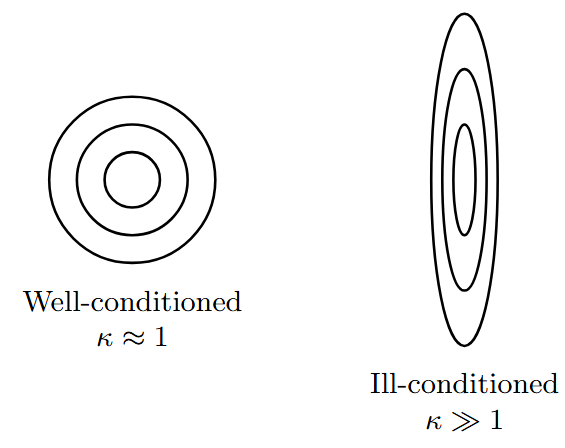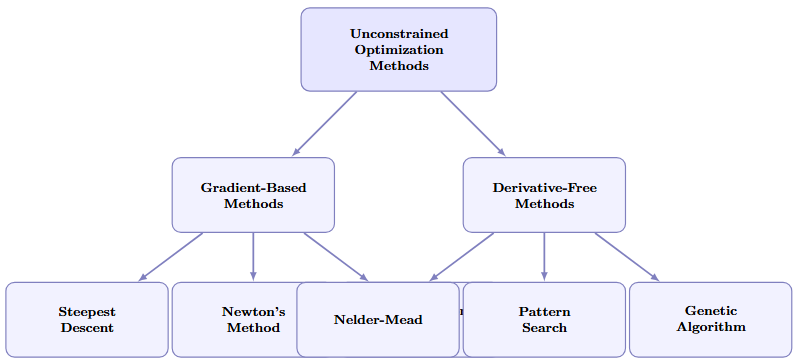Learning Objectives
By the end of this lecture, you will be able to:
-
Define unconstrained nonlinear optimization problems mathematically
-
Identify key characteristics that distinguish nonlinear from linear optimization
-
Recognize real-world engineering applications of unconstrained optimization
-
Understand the role of objective function properties in method selection
-
Compare different optimization methods and their trade-offs
Problem Formulation and Mathematical Foundation
Mathematical Problem Statement
Definition
An unconstrained nonlinear optimization problem seeks to find:
where \(f: \mathbb{R}^n \rightarrow \mathbb{R}\) is a nonlinear objective function.
Key Components:
-
Decision variables: \(x = [x_1, x_2, \ldots, x_n]^T \in \mathbb{R}^n\)
-
Objective function: \(f(x)\) (cost, performance metric, error)
-
Domain: Entire space \(\mathbb{R}^n\) (no explicit constraints)
-
Goal: Find optimal point \(x^* = \arg\min f(x)\)
Optimality Conditions
For a smooth function \(f(x)\), necessary conditions for optimality:
First-Order Necessary Condition
At a local minimum \(x^*\):
Second-Order Sufficient Condition
If \(\nabla f(x^*) = 0\) and \(\nabla^2 f(x^*) \succ 0\) (positive definite), then \(x^*\) is a strict local minimum.
Note: These conditions are local - global optimality requires additional analysis or convexity assumptions.
Engineering Significance and Applications
Why Unconstrained Optimization Matters in Engineering
-
Design Optimization:
-
Minimize weight while maintaining structural integrity
-
Optimize aerodynamic shapes for reduced drag
-
Tune control system parameters for optimal performance
-
-
Parameter Estimation:
-
Fit mathematical models to experimental data
-
Calibrate material properties from test results
-
Identify system parameters in dynamic models
-
-
Machine Learning Applications:
-
Train neural networks for engineering predictions
-
Optimize hyperparameters in ML algorithms
-
Minimize prediction errors in regression models
-
Real-World Engineering Examples
Example: Structural Design
Minimize the weight of a truss structure:
where \(x = [A_1, A_2, \ldots, A_n]^T\) are cross-sectional areas.
Example: Parameter Estimation
Fit a nonlinear model to experimental data:
where \(\theta\) are model parameters, \(y_i\) are measurements.
Example: Control System Tuning
Minimize integral squared error for PID controller:
Characteristics of Nonlinear Optimization Problems
Key Characteristics vs. Linear Optimization

Challenges in Nonlinear Optimization
-
Multiple Local Optima:
-
Function may have many valleys and peaks
-
Local search methods may get trapped
-
Global optimum not guaranteed
-
-
Ill-Conditioning:
-
Steep valleys or flat regions
-
Numerical instability
-
Slow convergence rates
-
-
Dimensionality:
-
Curse of dimensionality in high dimensions
-
Visualization becomes impossible
-
Computational complexity increases
-
-
Derivative Information:
-
May not be available analytically
-
Numerical approximation introduces errors
-
Discontinuities in derivatives
-
Objective Function Properties
Critical Properties of Objective Functions
Convexity
A function \(f(x)\) is convex if:
for all \(x, y \in \mathbb{R}^n\) and \(\lambda \in [0,1]\). Importance: Convex functions have no local minima (only global).
Smoothness
-
\(C^0\): Continuous function
-
\(C^1\): Continuously differentiable (gradient exists)
-
\(C^2\): Twice differentiable (Hessian exists)
Importance: Determines which optimization methods can be applied.
Condition Number and Convergence
Condition Number
For a quadratic function \(f(x) = \frac{1}{2}x^T A x\):
Impact on Optimization:
-
\(\kappa \approx 1\): Well-conditioned, fast convergence
-
\(\kappa \gg 1\): Ill-conditioned, slow convergence
-
Affects choice of optimization method

Overview of Optimization Methods
Classification of Optimization Methods

Gradient-Based Methods
General Framework: \(x_{k+1} = x_k + \alpha_k d_k\)
-
Steepest Descent: \(d_k = -\nabla f(x_k)\)
-
Simple implementation
-
Guaranteed descent direction
-
Slow convergence for ill-conditioned problems
-
-
Newton’s Method: \(d_k = -[\nabla^2 f(x_k)]^{-1} \nabla f(x_k)\)
-
Quadratic convergence near solution
-
Requires Hessian computation and inversion
-
May not converge if Hessian is not positive definite
-
-
Quasi-Newton (BFGS): Approximates Hessian inverse
-
Superlinear convergence
-
Lower computational cost than Newton’s method
-
Robust for engineering applications
-
Method Comparison and Selection Criteria
| Method | Derivatives | Convergence | Robustness | Cost/Iteration |
|---|---|---|---|---|
| Steepest Descent | \(\nabla f\) | Linear | High | Low |
| Conjugate Gradient | \(\nabla f\) | Superlinear | Medium | Low |
| Newton’s Method | \(\nabla f, \nabla^2 f\) | Quadratic | Low | High |
| Quasi-Newton (BFGS) | \(\nabla f\) | Superlinear | High | Medium |
| Trust Region | \(\nabla f, \nabla^2 f\) | Robust | Very High | High |
| Nelder-Mead | None | Slow | Medium | Low |
Selection Guidelines:
-
Smooth, well-conditioned: Newton’s method
-
General engineering problems: BFGS
-
Large-scale problems: Conjugate gradient
-
Noisy/discontinuous: Derivative-free methods
Practical Implementation Considerations
Implementation Challenges
-
Initial Guess Selection:
-
Critical for convergence to good local minimum
-
Use engineering insight or multiple starting points
-
Consider bounds on physical variables
-
-
Convergence Criteria:
-
Gradient norm: \(\|\nabla f(x_k)\| < \epsilon_g\)
-
Function change: \(|f(x_{k+1}) - f(x_k)| < \epsilon_f\)
-
Step size: \(\|x_{k+1} - x_k\| < \epsilon_x\)
-
-
Numerical Issues:
-
Finite precision arithmetic
-
Gradient approximation errors
-
Matrix conditioning problems
-
-
Scaling and Preconditioning:
-
Normalize variables to similar scales
-
Use physical units appropriately
-
Precondition ill-conditioned problems
-
Summary
Key Takeaways:
-
Unconstrained nonlinear optimization is fundamental to engineering design and analysis
-
Nonlinearity introduces challenges: multiple optima, ill-conditioning, dimensionality
-
Objective function properties (convexity, smoothness, conditioning) guide method selection
-
Gradient-based methods offer fast convergence but require derivatives
-
Derivative-free methods handle noisy or discontinuous functions
-
Practical implementation requires careful attention to initialization and convergence
Next Lectures
-
Line Search Methods and Step Size Selection
-
Gradient-Based Algorithms: Steepest Descent and Conjugate Gradient
-
Newton and Quasi-Newton Methods
-
Trust Region Methods